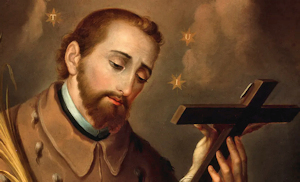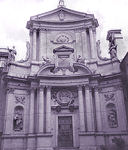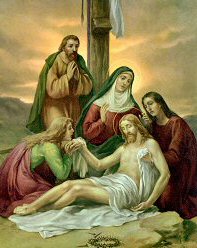Lent: March 20th
Saturday of the Third Week of Lent
Other Commemorations: St. John Nepomucene, Priest and Martyr (RM)
Free eBook:

|
| Free eBook: Liturgical Year 2023-2024, Vol. 4 |
» Enjoy our Liturgical Seasons series of e-books!
"Everyone who exalts himself will be humbled, and the one who humbles himself will be exalted." (Lk. 18:14) "Even if we should have mounted to the very pinnacle of virtue, let us consider ourselves last of all; having learned that pride is able to cast down even from the heavens themselves him who takes not heed, and humbleness of mind to bear up on high from the very abyss of sins him who knows how to be sober. For this it was that placed the publican before the Pharisee." — St. John Chrysostom
The Station is in the church of St. Susanna, virgin and martyr of Rome. The reason this church was chosen is because the history of the chaste Susanna, the daughter of Helcias, was read today in the Tridentine Mass.
Meditation- Mary's Acceptance of All, for Love of Us
Mary, there present as eyewitness to the sacred Passion of her divine Son on Good Friday, was destined to be present in spirit and maternal interest at future scenes in the unending tragedy of Christ Jesus' Passion in His members through all the Christian centuries. She was destined to be present precisely in that high office to which Jesus Himself would assign her at the foot of His cross on Calvary, as the Mother of all who live the divine life of the children of the Second Adam. Hence, to fit her for this office of Mediatrix who would have Christ-like compassion on all our human infirmities, she too must be tempted in all things as we are (without sin), that we might with confidence go to the throne of her mercy, there to obtain the precious grace of Christ-like obedience through her who herself learned perfect obedience by the things which she suffered with her divine Son. She also must be tested that, by her union with the very humiliation and suffering with which the Son purchased His title of High Priest, the Mother too might at the same time purchase her title — Mediatrix of all the graces to be dispensed from the treasury of the Sacred Heart of Him, who alone is in His own right the great High Priest, the universal and plenipotentiary Mediator of the New Testament.
Mark well, therefore—it was on Good Friday, during these hours of darkness and shame and anguish which Mary shared with Jesus most intimately, that the Savior fountains of the Second Adam poured their tenderest mercifulness into the heart of the Second Eve so copiously, that until the Book of Life is filled the whole world might with unlimited filial confidence have recourse to Mary—
The Health of the sick,— Our Way to the Father by Rev. Leo M. Krenz, S.J.
The safe Refuge of sinners,
The sympathetic Comforter of the afflicted,
The unfailing Help of Christians
Things to Do:
- Pray the Litany of Humility.
St. John Nepomucene (Nepomuk)
 Born at Nepomuk, Bohemia, 1340; died in Prague, March 20, 1393; canonized in 1729. Saint John used the name of his native town for his surname instead of his family name of Woelflein or Welflin. He studied at the University of Prague, was ordained, and became a canon. In time, he became vicar general of Archbishop John of Genzenstein at Prague and according to tradition incurred the enmity of dissolute King Wenceslaus IV when he refused to reveal what Queen Sophie, Wenceslaus’ second wife, had told him in confession. Of a retiring disposition, Father John repeatedly refused bishoprics which were offered to him.
Born at Nepomuk, Bohemia, 1340; died in Prague, March 20, 1393; canonized in 1729. Saint John used the name of his native town for his surname instead of his family name of Woelflein or Welflin. He studied at the University of Prague, was ordained, and became a canon. In time, he became vicar general of Archbishop John of Genzenstein at Prague and according to tradition incurred the enmity of dissolute King Wenceslaus IV when he refused to reveal what Queen Sophie, Wenceslaus’ second wife, had told him in confession. Of a retiring disposition, Father John repeatedly refused bishoprics which were offered to him.
In 1393 (or 1383 according to some), he became involved in a dispute between Wenceslaus and the archbishop when the king sought to convert a Benedictine abbey into a cathedral for a new diocese he proposed to create for a favorite when the aged abbot died. The archbishop and John thwarted him by approving the election of a new abbot immediately on the death of the old abbot. At a meeting with John and other clerics, Wenceslaus flew into a rage, tortured them so that John was seriously injured, and then had him murdered and thrown into the Moldau River at Prague (Attwater, Benedictines, Delaney)
Saint John is portrayed in art as an Augustinian canon with a fur almuce and a bridge near him. He may hold his finger to his lips and have seven stars around his head, or wear a padlock on his lips (in Austria and Bohemia). John, patron of confessors and bridges, is venerated in Austria and Spain (Roeder).
—by Katherine Rabenstein, Saints of the Day
Patronage: against calumnies; against floods; against indiscretions; against slander; bridge builders; bridges; canons; confessors; for discretion; for good confession; mariners, sailors, boatmen, watermen; running water; silence; spiritual directors; Bohemia; Czech Republic; archdiocese of Prague, Czech Republic; Slovakia; Venice, Italy
Symbols and Representation: halo with five stars; cross; bridge; angel indicating silence by a finger over the lips; priest's biretta
Highlights and Things to Do:
- Read more about St. John Nepomucene:
- Read about the location of Saint John of Nepomuk's Martyrdom.
- The Statue of St. John of Nepomuk on Charles Bridge in Prague.
- See Christian Iconnography for depictions of St. John.
- Learn more about Prague and the Czech Republic and St. Vitus Cathedral, supposedly started by St. Wenceslas in the 10th century as a small chapel to house relics of St. Vitus and were in the 14th century St. John Nepomucene was buried after being executed for refusing to violate the seal of the confessional.
- Read about the Infant Jesus of Prague and pray the chaplet.
- Bake a loaf of bread for dinner and serve Pilsner beer in honor of St. Wenceslas. See also Catholic Cuisine for other ideas.

Wednesday of the Fifth Week of Lent
Station with San Marcello al Corso (St. Marcellus at the Corso):
The Station today is at the church of St. Marcellus at the Corso. Legend claims that Pope St. Marcellus (308-309) was sentenced by Emperor Maxentius to look after the horses at the station of the Imperial mail on the Via Lata, where the Via del Corso now lies. He was freed by the people, and hidden in the house of the Roman lady Lucina (see also San Lorenzo in Lucina). He was rearrested, and imprisoned in the stables.
For more on San Marcello al Corso, see:
For further information on the Station Churches, see The Stational Church.







